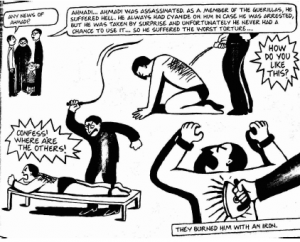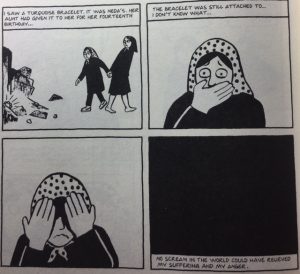Hello again, ASTU 100!
Coming into UBC as a first-year student, my expectations for an English class definitely changed from the perspective of a high school student. The typical expectations were summed up with novels, critical analyses, and common themes with English literature, such as identity or global citizenship, so I was surprised that Dr. Luger assigned the ASTU class with Persepolis. Persepolis, a “graphic memoir” created by Marjane Satrapi, is a telling of her own childhood through the lens of Marji, a young girl who grew up in Iran during a time of incredible political unrest.
I grew up with reading comic books, mostly from my childhood libraries, ranging from adventure stories with themes of friendship to popular Japanese action mangas. I was not aware that graphic books were published with the intention of campaigning for strong political messages. However, Persepolis surrounds many political and social justice themes, such as the oppression of women through the mandatory dress standards and the inhumane torture during a revolution and the human cost of war and revolution. Despite these mature themes, Satrapi is able to communicate these controversial subjects through a child’s understanding and interpretation of her memory and she was able to do this through the format of the “graphic memoir”.
As I was reading Persepolis, I initially thought that it may have been easier to complete than a standard book or article, but I realized that it required a deeper analysis because of many symbolic meanings in its context such as the colour scheme, the artistic style, or how Satrapi chose to draw a particular panel. This raises a question for me to ponder: What differences does it make in creating a graphic book, compared to writing a standard book?
In the form of a graphic book, Satrapi constructs and emphasizes her storytelling with the focus of “The Story of a Childhood”. From the beginning of the book, Marji introduces herself and the background of her story, the Islamic Revolution. From there, the sequences of events are always shown through her own interpretation and memories of when she was a child living with the influence of her parents who were political activists. The childhood as a perspective becomes the focus of how the graphics are structured and drawn, most evidently seen within Satrapi’s choice of art style itself, showing simplistic and cartoonish characters, and how certain events are underlyingly censored.

Violent scenes that were represented from Marji’s perspective of inhumane treatment from the religious Fundamentalists towards rebels and dissenters were toned down to fit with a child’s perspective. Any panel that was meant to depict violence was censored, reasoning that a young girl simply could not comprehend the graphic violence within the limits of a childish imagination. This was obviously shown when Marji and her parents were visited by two old friends, who were political prisoners because of their revolutionary ideals. They recounted their story of the torturing they and their colleagues suffered, in which Satrapi drew said scenes, cartoon figures with whip marks and cut up corpses, proving to be very graphic if the art style was any more realistic.
Many popular comic books are often drawn with a sense of realism attached to the characters and art style, especially within superhero comics, perhaps appealing to a more mature audience. However, the modern superhero and adventure comics are often drawn with colours, adding to the appeal of attractive artwork. The lack of distracting, but fun colours in Persepolis is a contrast to its cartoonish art style, and it highlights the actual depth of the political meaning with the plain black and white text and images.

Images (or the lack of images) can often convey emotions that simply cannot be represented with words, no matter how articulate the description may be. The intensity of traumatic experiences and emotions are difficult to convey to its true complexity, and as images are more simplistic, the more difficult it is seen in trying to recall the authenticity of the moment. In a powerful scene, Satrapi recalls when bombs had been dropped in Marji’s home neighbourhood, witnessing the aftermath with the death of her friend. Satrapi chooses to leave a panel pitch black, in response to the lack of words or images that can truly describe what Marji and the author both feel in the context of that moment.
The movie Persepolis that was adapted from the book was made in 2007, which followed very closely to the Satrapi’s art style and sequence of events. In the animation, it was originally voiced in French and subtitled and dubbed in English, just as the graphic book version has been translated into many other languages as well. What made Satrapi (who also directed the film) choose to play the film in the same style as her book, rather than using real actors?
To keep the authenticity of the original recollections Satrapi explored with her childhood, she used a number of techniques to emphasize the perspective she had and the intensity of emotions in her story such as a childlike art style, and the use of censorship. I believe that in using the “graphic memoir” as a way to script an autobiography, it retains the sense of originality that holds true to the genre of autobiographies and memoirs.
Thank you for reading! Until next time!
-Jessie Y.
